Museums and Exhibitions in New York City and Vicinity
| Home | | Museum Guide | | International | | Architecture & Design | | Theater |
GLENN LONEY'S MUSEUM NOTES
CONTENTS, November 2002
[01] Art of Sam Norkin
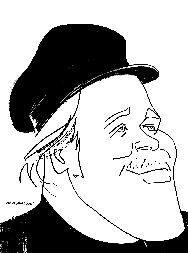
Caricature of Glenn Loney
by Sam Norkin.
[02] Toledo Masterpieces at Frick
[03] American Legacy at Whitney
[04] Einstein at Natural History Museum
[05] Thaw Collection at the Morgan
[06] Avant-Garde Architecture at MoMA QNS
[07] Adventures of Hamza at BMA
[08] Dagobert Peche at Neue Galerie
[09] Before "Le Corbu" Was Le Corbusier
[10] Contemporay Aboriginal Art
[11] Chinese Tomb Sculptures
[12] Chinese Ceramic Busts from Xian
[13] Genghis Khan's Legacy at Met
[14] Nomadic Art at Met
[15] Ideas of Origin in African Sculpture
[16] Chassériau/Unknown Romantic
[17] Janice Levin's Impressionists at the Met
[18] French Drawings from the Met's Lehman Collections
[19] Windsor Set Wartime Style-Show
[20] Richard Avedon's Portraits at Met
[21] Century of Photo-Portraits at Met
[22] Kafka & Prague at Jewish Museum
[23] Adolph Gottlieb: Artist's Odyssey
[24] Sanford Smith's 20th Century Art at the Armory
[25] "Strangers" Coming to International Photography Center
You can use your browser's "find" function to skip to articles on any of these topics instead of scrolling down. Click the "FIND" button or drop down the "EDIT" menu and choose "FIND."
For editorial and commercial uses of the Glenn Loney INFOTOGRAPHY/ArtsArchive of international photo-images, contact THE EVERETT COLLECTION, 104 West 27th Street, NYC 10010. Phone: 212-255-8610/FAX: 212-255-8612.
Copyright © 2000 Glenn Loney.
For a selection of Glenn Loney's previous columns, click here.
At the NY Public Library
For the Performing Arts:
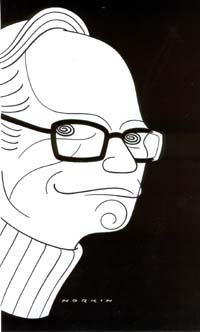 |
SAM NORKIN--As Sam sees himself! Photo: Courtesy NYPL/©Sam Norkin/2002. |
THEATER.INK: The Art of Sam Norkin
[Closing 18 January 2003] Sam Norkin's wonderful new show of performing arts caricatures at the Lincoln Center Library for the Performing Arts must take pride of place this month. Even over El Greco at the Frick and Avedon at the Met Museum.One reason is that the caricature which always opens this column was made expressly for your reporter by Sam Norkin, who is a long-time colleague and friend.
But Sam Norkin has been capturing the essences of the great shows and stars of the Great White Way since 1940. I began writing about them only in 1960, so Sam has been on the scene for over sixty years!
The current retrospective of Norkin's Performing Arts artworks spans these decades, evoking memories of great moments not only in the theatre, but also at the opera and the ballet.
Norkin's drawing of Alfred Hitchcock directing Mr. and Mrs. North is the oldest in this new show, dating from 1940 and the long-defunct New York Herald Tribune. The most recent artful caricature is of this season's mega-hit Hairspray.
Many New Yorkers will know Sam Norkin's work more immediately from the Daily News, where he has long been a most valued visual commentator on Manhattan's arts-scene.
Leading the press through his show, Norkin noted that classical music and opera are among his most favored forms of performance. So it's no wonder that he has made impressive sketches of Leonard Bernstein, Kurt Mazur, and other giants of the music-world.
His portrait of the Metropolitan Opera's General Manager, Joe Volpe—vulpinely grinning, overpowering atop the Met building—captures his managerial essence.
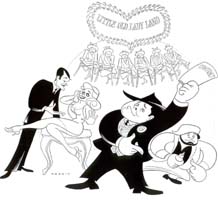 |
THE PRODUCERS--Norkin's brush captures the leads and the Old Ladies. Photo: Courtesy NYPL/©Sam Norkin/2002. |
Stars of Rock 'n Roll and other forms of popular music all let Norkin reveal their secrets in knowing and highly stylish caricatures.
Not only are Norkin's affectionately satiric portraits notable for capturing essential facial features and body-language, but they are also outstanding for the dynamics of his composition. His drawing for the ballet of The Moor's Pavanne is visual dynamite!
A Norkin illustration reaches right out of the page to metaphorically grab the reader-onlooker by the shoulders.
His "staging" of his many show-biz impressions—recreating a major scene or emotional moment—is often more powerful than the effects a show's designer and director have been able to achieve.
At this show's opening, Norkin noted that he was the first newspaper artist to make show drawings when new productions were still trying out on the road. The Times and others always waited to see if shows would be hits before they ran a major visual.
The beneficial results of this "advance artwork" were that shows-in-progress would already have a highly recognizable image as they traveled the out-of-town circuit from Boston to New Haven to Philly. When they arrived on Broadway, the Norkin images were the effective logos for the new productions.
At the Frick Collection:
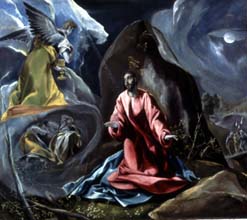 |
AGONY IN THE GARDEN--Masterpiece by El Greco-of Toledo/Spain-on loan to the Frick from Toledo/Ohio Museum of Art. Photo: Courtesy Toledo Museum of Art. |
European Masterpieces
From Toledo Museum of Art
[Closing 5 January 2003]
"Infinite Riches in Little Room" takes on new meaning with the current show at the Frick Collection. But the powerful paintings from the Toledo Museum of Art now on view in the Oval Gallery and the Garden Court almost overpower the spaces in which they are shown. The centering of Piero di Cosimo's Adoration of the Child in the intimate Oval—framed by the great entrance portal from the Court—in fact takes the viewers' eyes away from the important paintings at the upper end of the always verdant indoor garden.
A major loan exhibition of only twelve paintings may seem a contradiction in terms. But these masterworks—collectively somewhat disparate in subjects and styles—are so striking that a visit to the Frick could concentrate on them. And leave Henry Clay Frick's own favorite canvases for another day…
My favorite is James-Jacques-Joseph Tissot's London Visitors. This may seem strange, with remarkable works by El Greco, Pissarro, Cézanne, Primaticcio, Gainsborough, and Boucher on view.
Tissot has done something very special with verticality in his unusual study of tourists in the columned portico of London's National Gallery. A distinctively dressed Victorian couple stand on top of the steps in front of the columns. Behind them, through the pillars, the slim, soaring steeple of St. Martin's-in-the-Fields is faintly seen.
Slightly below them on the steps is a young scholar-guide in his school's quasi-clerical uniform, looking out of the frame toward the right. The man leafs through his guide-book. The woman seems to be looking out at the viewer.
Or had her eye fallen on that lone cigar, discarded on the steps below? What a curious detail in such an elegant arrangement…
Farther back on the entrance platform, another young scholar is guiding a lady-tourist's gaze towards Trafalgar Square. She is wearing a complicated hat and carries a plaid shawl over her arm.
A great deal of detail to study, but the thrust of the painting is in its verticals. For some, Tissot's concerns with fashionable people and social scenes confines him to the second rank as a painter.
I first came to recognize his talents in Edinburgh at an impressive retrospective. His visions of both French and English people of his day were quite arresting—at least for me.
But my admiration for the Toledo Tissot in no way detracts from my amazement at Bassano's Flight into Egypt, Primaticcio's Ulysses and Penelope, and El Greco's Agony in the Garden.
Nor from my surprise at finding a canvas by François Boucher which does not celebrate the sensual frivolities of 18th century French court life. His Mill at Charenton is a landscape of quite a different kind. No lovely ladies in swings.
The Toledo Museum has been celebrating its centenary. So the loan of these masterpieces to the Frick—and the handsome catalogue with accompanies the show—is a Manhattan extension of that celebration.
The Museum also has good reason also to celebrate the generosity of its major patron, Edward Drummond Libbey. Ten of the canvases on loan were acquired through the Libbey Endowment!
So, if you have ever used the glass and glasswares of Libbey-Owens-Ford, you may have also been indirectly contributing to the excellences of the Toledo Museum of Art!
At the Whitney Museum of American Art:
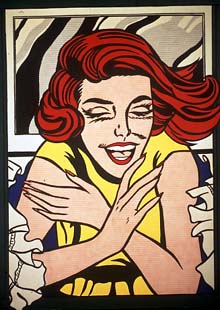 |
GIRL IN WINDOW--Roy Lichtenstein's cartoonish image now in Whitney's Permanent Collection. Photo: Courtesy Whitney Museum of American Art/2002. |
An American Legacy, A Gift To New York
[Closing 26 January 2003] The important postwar American masterworks recently bestowed on the Whitney—through the generosity of its Board of Trustees—provide a cross-section of the Usual Suspects in a Survey of Contemporary American Art.Not that the Museum of Modern Art—and even the Metropolitan—do not already own major works by the same American artists. Not to mention every British and European Art Museum worthy of the name…
Names such as Jasper Johns, Robert Rauschenberg, Chuck Close, Jackson Pollock, Roy Lichtenstein, and certainly Andy Warhol are now virtually Household Words.
Nor is the Whitney exactly deficient in its holdings of these artists. And such other American luminaries as Helen Frankenthaler, Barnett Newman, Claes Oldenburg, Mark Rothko, Ed Ruscha, Donald Judd, Ellsworth Kelly, Jim Dine, Franz Kline, Lucas Samaras, Clyfford Still, Kenneth Noland, & Sol LeWitt.
In the wake of the Whitney's recent eye-opening exhibition of the California paintings of Wayne Thiebaud, I could wish that one of his gravity & perspective-defying visions of the Bay Area and the Sacramento Valley had been included in these trustee-purchases.
But the Bay Area is, in fact, represented by Jay De Feo, with her Crescent Bridge 1. As Jay and I were friends at UC/Berkeley—and she designed my production of Chekhov's The Boor in California Hall—I've always regretted that she and her works were not better known on the East Coast.
But Jay's obsession with her major and very weighty work, The Rose, almost precluded a large volume of painting or the pursuit of a national reputation. This strange, enigmatic virtual sculpture of paint is now in the UC/Berkeley Art Gallery.
As deployed artfully in the Whitney's fourth-floor galleries, the new acquisitions are arresting, impressive, and often even amusing. They also provide an instant visual-seminar for those who need a crash-course on American Pop, Abstract Expressionism, the special thrust of the New York School, and other art-vogues.
An American Legacy, A Gift To New York would, however, be much more impressive had the paintings, installations, and sculptures been given to the Whitney by the artists themselves! Not purchased at high prices by various Trustees… Of course that has added even more cachet—and steeper prices—to these artists' works.
Marla Prather is the very knowledgeable curator of this stunning exhibition.
At the American Museum of Natural History:
 |
ALBERT EINSTEIN TAKES A SPIN--Poster-image for Museum of Natural History Show. Photo: ©CIT/2002. |
EINSTEIN
[Closing 10 August 2003] It should in no way diminish your admiration for Albert Einstein to discover that he was a devil with the ladies. Images of the good-natured old scientist in baggy sweaters suggest a beloved grand-dad rather than a lover.But fame has always been a powerful aphrodisiac. Women were attracted to the great theoretical physicist. And not because of his equations.
Unfortunately, Einstein was not as thoughtful—or as faithful—as one might have expected of a truly great man who was so immensely concerned with the broader band of Humanity. Especially as a life-long Pacifist.
One of the many virtues of the amazing new show at the American Museum of Natural History is the way in which Einstein—Man, Scientist, Humanist—is revealed whole.
Personal letters, diaries, and photos are here shown in public for the first time. Einstein's now historic letter to President Franklin Delano Roosevelt—warning of Nazi work on atomic fission—is displayed side-by-side with FDR's answering letter. And Einstein's later letter, expressing fears about actually using the atomic bomb. A letter which apparently was never allowed to reach the President's desk…
Albert Einstein won the Nobel Prize for Physics in 1921. Later in life, the Swedes should have also awarded him the Nobel Prize for Peace. But they did not…
Einstein's lifeline is illuminated in this show, including his passionate support—even early in the 20th century—for a Jewish Homeland in Palestine. He was even offered the Presidency of Israel by the late Abba Eban.
Einstein's relations as man, scientist, pacifist, and Jew with Germany and Germans is also strongly outlined visually and textually.
The wonder of the new show—which will tour internationally—is that it has been designed so ingeniously that even Einstein's most abstract speculations begin to seem almost understandable.
E=mc squared may be the most significant equation of the 20th century. But it is definitely not easy to explain. Text, diagrams, and visuals, however, bring one closer to an intimation of what Einstein perceived in the Universe.
Original manuscript pages of his General Theory of Relativity are on display for the first time in the United States. As well as more personal objects and artifacts.
Considering Einstein's long tenure in Princeton at the Institute for Advanced Study—where he could pursue his speculations free of financial and final-exam-grading worries—it is very impressive that he made his first important discoveries while working in the Swiss Patent Office! At age 26, in his spare time!
This compactly-designed show will travel to the co-organizing Skirball Cultural Center in Los Angeles and on to the Hebrew University of Jerusalem.
The show's poster-boy image is a wild-haired, grinning Einstein taking a turn on his bicycle! With the Cosmos in the background…
Of course there is a handsome companion publication: The Einstein Scrapbook. And a special Einstein Gift Shop!
Teachers may be interested to know that their pension-fund, TIAA-CREF, is the Corporate Tour Sponsor. Just in case you wondered why your retirement benefits are stuck at their present levels…
At the Morgan Library:
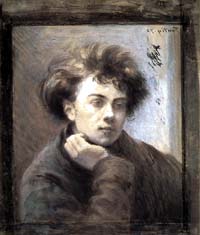 |
RIMBAUD BY FANTIN-LATOUR--From Thaw Collection now at Morgan Library. Photo: ©Morgan Library/2002. |
The Thaw Collection:
Master Drawings & Oil Sketches
[Closing 19 January 2003]
The most recent gifts of Eugene and Clare Thaw to the Morgan Library are of course a fascinating reason for paying this great New York institution a visit. But you should also plan to make a bee-line to its Madison Avenue site because Mr. Morgan's Library, his magnificent office, the concert-hall, the glass-atrium, and the galleries will soon be closed to the public.
In the handsome Morgan lobby, an impressive and detailed wood & plastic model of the structural enhancements planned for a possible 2006 completion make it visually clear why the public will not have access for the next three or four years.
Italian architect Renzo Piano and his Workshop have devised a new plan which will of course preserve the three major landmark buildings on the site: the historic Morgan Library, the Annex, and the mansion which Morgan built for his son.
But it will provide a new Madison Avenue entrance, a large basement theatre/lecture hall, added stack-space, restoration & research areas, and steel & glass levels linking the landmarks.
The research library will remain available to bona fide scholars. But January will be the last time you can admire J. P. Morgan's favorite art-treasures, his Gutenberg Bible, and his splendid tapestried library.
The Thaws—who are very discriminating collectors—have already been generous donors to the Morgan of artworks and funding over the years. But the new show highlights their gifts of European Master Drawings and Oil Sketches since 1994.
[Concurrently, at the Metropolitan Museum of Art, important artifacts from Eugene Thaw's intriguing collection of Nomadic Art are also on display. How and where did he find some of these remarkable buckles, brooches, and ornaments? He is an art-dealer, as well as a collector, so he has Access that most people do not.]
The Thaw Collection of drawings and watercolors—given in installments to the Morgan—has been shown there in increments in 1975, in 1985, and in 1994. The current exhibition showcases works acquired in the past eight years.
In addition to pen sketches, water-colors, and oil sketches by modern masters—Fernand Léger, Vincent Van Gogh, & Edgar Degas—the Thaws have enriched the collection with 18th and 19th century works.
Some of the more interesting of these are by relatively unknown German and Austrian artists. Moritz von Schwind is certainly well known in Europe. And Philipp Otto Runge is becoming better known—even across the Atlantic.
How many admirers of Victor Hugo's Les Misérables are aware that this powerful novelist was also an artist of some power? One of the more mysterious and haunting works now on view at the Morgan is Hugo's Fantastic Castle at Twilight. He painted it on the Channel Island of Guernsey, when he was in political exile from his beloved France.
And how many American art-lovers are familiar with the images of Joseph Anton Koch, Johann Christian Reinhart, Josef Rebell, & Carl Philipp Fohr? Their sketches are a welcome change from those of some of their French contemporaries.
The Thaw's excellent "eye" for outstanding genre works will certainly make these artists more familiar to Morgan regulars when the reworked Library is finally completed.
My favorite drawing—from the point of dramatic architectural perspective—is Étienne-Louis Boullée's Interior of a Library. This could have been a proposal for a new Neo-Classical Bibliothèque Nationale.
The central vanishing point of this very wide drawing—over two feet wide, in fact—makes its long hall of classic columns seem almost endless. Boullée was something of a genius in devising fantastic architectures.
One or two were actually constructed, but this Grand Central Station of a Reading Room would never have proved practical. Imperially imposing, but not efficient.
The new Bibliothèque Nationale in the eastern purlieus of Paris is also impractical in the extreme, but it doesn't even have the virtues of Boullée's fantasy.
Someone had the jokey idea of making four high-rise corner-towers, opened like giant books. And cladding the walls with glass, which is death to stacks of books exposed to the scalding sun!
For the record, John Steinbeck's 100th Anniversary is a bit belatedly being celebrated at the Morgan—with exhibition of some of his notebooks and major manuscripts! Steinbeck—who also did research in the Morgan's Archives—gave the Library some very important originals. He wrote in a very small, neat hand!
At MoMA QNS:
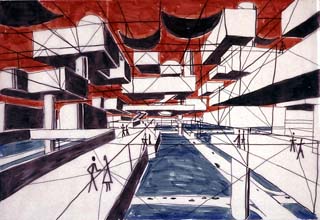 |
SPATIAL CITY/DIGITALLY IMAGED--Yona Friedman's avant-garde architecture at MoMA QNS. Photo: ©Museum of Modern Art/2002. |
The Changing of the Avant-Garde
[Closing 6 January 2003] Changing of the Avant-Garde is a catchy title, but it also indicates a shift in ideas and attitudes about the shapes, sizes, and purposes of structures in the 20th century.Obviously, as these designs—a gift to MoMA from the Howard Gilman Collection—are indeed visionary, imaginative, even surreal speculations on buildings of the future, they are not plans for actual structures. Some of them are clearly not buildable. Others are apparently not functional—if you study them closely—despite the artist/architects' fantasy that they might be actualized.
Among the better-known architectural artist/theorists on display are the Usual Suspects: Rem Koolhaas, Arata Isozaki, Aldo Rossi, Peter Eisenman, John Hejduk, Ettore Sottsass—of Memphis fame, and Raimund Abraham, whose towering Austrian Institute on a very narrow site on East 52nd Street has recently opened.
Austria's Hans Hollein has always created visionary designs. But one of his most imaginative—and skewed—designs now stands proudly in the heart of Vienna, reflecting the great medieval Cathedral of St. Stephen on its silver skin. To the immense distress of some traditionalists…
Hollein's designs for a proposed Salzburg Guggenheim Museum—carved out of the rocky heart of the Mönchsberg—may soon become an actuality also. Fought by conservative Salzburgers—and defeated in two separate votes—at this summer's Salzburg Festival, it finally seemed to have got the Green Light from Vienna. A triumph for the Guggenheim's empire-building director, Thomas Krens!
In effect—even if visionary architectural drawings were/are not blueprints for actual construction—they certainly can inspire new designs for homes, schools, offices, factories, and even museums and cemeteries. Which in some instances are virtually the same thing…
MoMA QNS is well worth a visit. Take the No. 7 subway/elevated from Times Square or Grand Central. It's only a few stops away.
But don't get on the wrong #7, or you'll end up in Woodhaven or some other godforsaken place on Long Island.
It is far easier to travel to Queens than to Staten Island. So it's a good thing MoMA—during its long closure on 53rd Street—did not decide to relocate to Sailors' Snug Harbor.
As construction speeds forward on the Museum of Modern Art's historic site mid-block between 53rd and 54th Streets, it's clear its exhibition galleries will be greatly enlarged. But it's also apparent that this monumental construction will not be completed and outfitted in only a year or two.
Fortunately, the new MoMA QNS—in the reworked Swingline Stapler factory—has big exhibition rooms and ample spaces for art-storage, restoration, and research.
Important works from MoMA's Permanent Collection are on view in one of these areas. There is also an intriguing exploration of Drawing Now: Eight Propositions. This closes 6 January, as does the stunning architecture show.
Some 250 wall-drawings, installations, and series are on view, related to the organizing principle of eight different "strategies" in contemporary drawing. The talents on display are an international palette of younger artists.
Drawing Happiness is one of the eight strategies. This is of course not easy to do. On the other hand, Science and Art, Nature and Artifice is a virtual catch-all.
At the Brooklyn Museum of Art:
 |
HAMZA IN BROOKLYN--Ancient Mughal Persian Epic Illustrated. Photo: ©Brooklyn Museum of Art/2002. |
The Adventures of Hamza
[Closing 26 January 2003] While the Hindu Epics of the Ramayana and the Mahabharata have become known in Europe and the Americas, owing largely to theatre and dance performances—notably Peter Brook's stunning version at the Mahabharata the Brooklyn Academy of Music—few have ever heard of the Persian Islamic Epic of the Hamzanama.Hamza was a legendary super-hero, a kind of Robin Hood. But he battled dragons and giants, not just the Sheriff of Nottingham and King John's soldiers. He is still a kind of folk-hero.
Hamza's Adventures offered the occasion in the 16th century for the creation of some of the most masterful and beautiful images in Mughal art. Outstanding Persian and Hindu artists were commissioned—commanded is more like it—to create a series of paintings outlining and detailing Hamza's remarkable exploits.
Akbar, the Mughal Emperor—of what is today Northern India—wanted the life and deeds of Amir Hamza recorded in both texts and images. When completed, the 1,400 pictures were bound into 14 huge volumes.
But Akbar's reign came to an end in 1605. And, in time, the books were dispersed, broken up. A Parisian art-dealer in the last century even split pages so he had two entire page-size images to sell from each original.
Only 200 of the images from this great work are thought to survive. And the current show at the Brooklyn Museum is the first time that some 58 of these will be seen together since the 18th century!
From MAK in Vienna come a core-group of 28 of the painted pages. This is the first time they have been seen outside the galleries of Austria's Museum für Angewandte Kunst—or MAK.
MAK is a museum for Applied & Decorative Arts—with a special interest in Modernism and its Central European precursors. So it's especially interesting that Mughal paintings from the late 1500s should have found their way into its considerable collections.
One of their special qualities—which surely appealed to the museum's curators—is the intricate detail of almost every aspect of each painted page. Not a roof-line is left undecorated. Roof-tops are intricate patterns of infinitely repeated designs.
Every leaf of trees and shrubs—which are merely flanking decorations to the main actions of major pictures—is painstakingly detailed. Nor are all the trees alike. By no means. In every centimeter of the paintings, the artists and their assistants strove for variety and strong contrasts of colors.
When you go to BMA—if you are so fortunate—do not merely go from image to image, following the saga of Hamza's adventures. Go back afterward and look closely at the fringes of costumes, the flowers and trees, and, of course, even the roof-tops.
You will be amazed. Part of the surprise in seeing these images in their original forms—rather than as catalogue or poster illustrations—is the almost enameled quality of the colors as applied. Applied Art, after all!
Instead of being merely bold colors laid or washed on flat surfaces, most of the colors in these pictures—especially in finely patterned areas—have been applied thickly. They stand up and out above the painting plane.
And so they dried long ago almost like cloisonné enamels. These create what art critic Alfred Frankenstein used to call "Light Traps." They catch the light from gallery illumination—or shifting light-sources—which gives them a very special substance, if not quite a 3D quality.
The catalogue is a wonder you will surely want to own and share. But the flat photographic reproductions can give you only a hint of the actual vibrant beauty of these originals. The hardcover catalogue costs $75, with only $45 for the paperback. But paper-bound books—especially of this size and weight—do not survive long. And this is surely a book many will want to enjoy!
Judy Chicago's Dinner Party—dinner-plates with vaginal themes and place-settings for famous women in history and legend—continues at BMA until 9 February. Then it remains part of the Museum's Permanent Collection.
At the Neue Galerie:
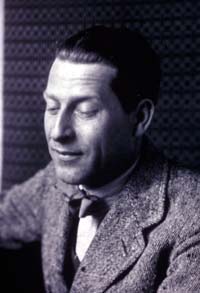 |
WIENER WERKSTÄTTE'S DAGOBERT PECHE--His arts & crafts now on view at Neue Galerie. Photo: Courtesy Neue Galerie. |
Dagobert Peche and the Wiener Werkstätte
[Closing 10 February 2003] This is an amazing survey of the variety of materials, styles, forms, and media in which the Austrian designer Dagobert Peche worked. Although the French would be pleased to label his general style as Art Nouveau—verging on Art Deco—it is in fact known in Mittel Europa as Jugendstil.Peche and his gifted artist/designer colleagues in the Wiener Werkstätte created some objects which are as modern today as when they were first imagined almost a century ago. That is certainly true of designs for furniture, silver, ceramics, and glass devised by Josef Hofmann and Kolo Moser.
Details borrowed from classicism—as well as the baroque and rococo—gave a special quality to Peche's own ceramics, silver, and fabric-designs. Before he joined the Werkstätte, he had been creating design-repeats for the firm of Backhausen. Today, you can still get some of his patterns in Backhausen yardage in Vienna's Kärntnerstrasse.
The current show in the Neue Galerie's third-floor galleries has some 400 drawings and objects designed by Peche. These are drawn from museums and private collections, most notably from Vienna's MAK, or Museum für Angewandte Kunst. Its name announces a focus on Applied Arts, which certainly applies to the art & craft of Dagobert Peche.
There is an irony about the aims of Peche and his fellow-artists, in the framework of the Wiener Werkstätte. Initially—as with the Arts & Crafts Movements in England and America—their goal was to design attractive articles for the homes and persons of working-class people, who otherwise would have to make-do with tawdry, kitschy fabrics, dishes, glasses, and furniture.
Unfortunately, the fine materials used and the skills and time required to make the WW designs into saleable realities cost far more than poor people could afford.
Nor were Austrian workers that thirsty for fine design in their habitats. Beer has always been the beverage of choice, so finely-blown WW champagne-flutes were not needed.
If you ever discover in a second-hand shop a trinket, a spoon, a leather-wallet that has the WW stamp somewhere on it, snap it up. Anything surviving from the Wiener Werkstätte is a prime Collector's Item now. Even if it was not designed by Dagobert Peche.
At the Bard Graduate Center:
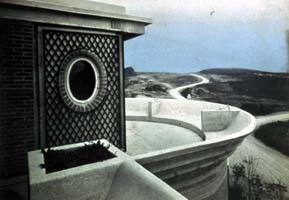 |
VILLA SCWOB--Designed by C-E Jeanneret before he became Le Corbusier. Photo: ©Artists Rights Society/2002. |
Le Corbusier Before Le Corbusier
[Closing 23 February 2003] Who was "Le Corbu" before he became internationally famous as the revolutionary architect Le Corbusier?His name was Charles-Edouard Jeanneret, a Swiss citizen by birth. His father engraved and enameled watches in one of the important Swiss watch-and-clock factories in La Chaux-de-Fonds.
The talented young Jeanneret could have followed in his father's footsteps. Indeed, in the new show at the Bard Grad Center gallery, there is a watch he decorated himself.
Fortunately, he decided to pursue his interests in architecture and design. While still in his late teens, he was already involved in designing homes and interiors for wealthy clients in La Chaux-de-Fonds.
His early studies at the School of Art in his hometown—plus extensive travels in Europe and as far as East as Istanbul—were formative in his later practice and in developing his theories of modern architecture.
The current exhibition marshals documents, drawings, decorations, photos, and models to demonstrate the maturation of Jeanneret. And to foreshadow his transformation into Le Corbusier.
Although his innovative designs for Villa Jeanneret-Perret and Villa Schwob, in La Chaux-de-Fonds, are already impressive, he included little of his early work in his Oeuvre complète, published in 1930. The current show seeks to fill in the blanks in the record.
There are also brochures available at Bard, urging donations for the restoration of La Maison blanche, as Villa Jeanneret-Perret came to be known. It is in urgent need of attention, even though it is already landmarked. You could hardly expect the impoverished Swiss government to pay for this?
Le Corbusier was famously opinionated and contrarian about architecture and the uses to which it was to be put. He wrote more books, manifestos, and articles than any other important modern architect.
His only US commission is the Carpenter Center at Harvard. He was a metaphorical thorn in the sides of fellow-planners for the UN Secretariat on the East River.
But Le Corbusier's unusual complex of ultra-modern buildings for Chandigarh, in India, remains one of his most important achievements. A living monument, in fact.
My first experience of his innovative design was the Chapel of Notre Dame du Haut in Ronchamps. I was teaching in Verdun and Nancy and drove down on a weekend with my devout French-Catholic secretary.
The chapel had just been sanctified. I loved especially the high stained-glass window with the inscription "Marie, qui brille comme le Soleil." But this is a Matisse evocation, not essential Le Corbu…
I was eagerly photographing the new sanctuary, outside and in. Madeleine simply looked stunned at the interior: "I could never pray in this building!"
New & Old at the Asia Society:
The Native Born:
 |
ABORIGINALS BARKING ANIMALS & FISH--Bark-paintings from Australia. Photo: Courtesy Asia Society/2002. |
Contemporary Australian Aboriginal Art
[Closing 5 January 2003] As Australia was initially settled by English convicts and transported Women of the Streets, the original inhabitants—derisively called "Abos"—were gradually driven away from the most desirable lands and locations along the south and eastern coasts.Long before Europeans in South Africa began their official and brutal policy of Apartheid—to separate the white population from the much larger black one—the English settlers had found ways to enforce separation and even to discourage the Aboriginal population from growing.
Fortunately, the forced restriction to fairly undesirable areas of the vast Australian continent made the beliefs, rituals, customs, and artifacts of the Aboriginal Peoples even more important and sacred to them.
Thus, the ancient culture has been preserved unbroken. And its expression in the arts of drawing, painting, weaving, and carving still evoke the Primal Dream Time in which all things were created.
The handsome and intriguing exhibition now at the Asia Society includes traditional bark paintings of fish, snakes, animals, and birds from a Nature which is always at hand for these remarkably inventive native artists.
Raised white paint on often uneven pieces of brown bark not only evokes living things, but it also is deftly used to create intricate patterns and designs.
Of course bark-paintings are not the only artifacts on view. And there are also wall-texts and maps to document the repression and restriction of the Aboriginals for many decades. Until they won a measure of freedom…
This show is part of the Asia Society's Australia OutFront 2002 initiative. If Australia isn't physically attached to Asia, it certainly is in the general area at least.
Traditional & Contemporary Chinese Ceramics:
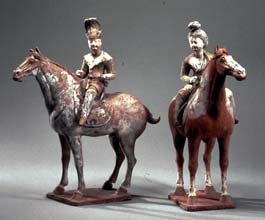 |
WHICH WAY DID THEY GO?--Ancient Chinese tomb-figures of riders and horses. Photo: Courtesy Asia Society/2002. |
From Court To Caravan:
Tomb Sculptures from the Solomon Collection
[Closing 9 February 2003]
Some of these tomb figures, designed—as with Egyptian burial artifacts—to serve the deceased in the Afterlife, still bear traces of the earth in which they were buried for centuries. While some of the figures from the Solomon Collection are fairly simple in outline and detail, a number are impressively sculpted and decorated.
Two ceramic horses, for instance, are wonderfully lifelike. And their detailed bridles, harness, and bolts of silk cloth provide an amazing documentation of one aspect of how the Silk Trade was carried on.
Many of the 40 figures on display attain a sophistication and naturalism which cannot be matched by similar ceramics in the West during the same periods.
This is all the more remarkable as these impressive objects—often churned out by busy workshops—were not intended for the enjoyment or edification of the living. They were interred with the body of the deceased, ostensibly to maintain for him in the Spirit World the same level of privilege and service to which he had been accustomed in life.
But Mankind being what it has always been, we can imagine that the larger, the more detailed, the more embellished the figures were at the point of interment, the bigger and better the impression they would make on mourners of the Wealth and Power of the Ruler—or relative—who had just passed on.
The Solomon figures span the centuries from the Han to the Tang Dynasty—almost a Millennium! As burials became greater occasions for showing-off—even in death—fine glazes and even gold-leaf were added to already strong sculptures.
The early Qin Emperor's terra cotta army of thousands in Xian is surely the most impressive cache of tomb-figures ever to be discovered. But they lack glazes and gold-leaf. How splendid they might be, had such added evidence of wealth been important to the Builder of the Great Wall.
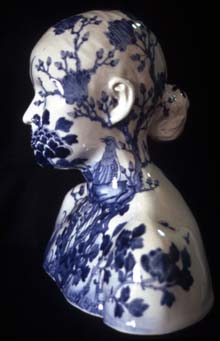 |
FEELING BLUE--Ah Xian paints his busts. Photo: Courtesy Asia Society/2002. |
China Refigured: The Art of Ah Xian
[Closing 9 February 2003] The gifted Chinese artist Ah Xian has nothing to do with the terra cotta army of Xian. But he is in fact working brilliantly in ceramics. Namely, glazed porcelain.He not only has nothing to do with Xian, but also very little with his birth-city of Beijing—1960—as he now lives and creates in Sydney, Australia.
But the cultural tensions between his homeland and his new land urged him to explore an ancient artform which could provide a kind of visual bridge. His major works—many of which are on view at the Asia Society—are a series of porcelain busts of men and women, decorated with patterns, designs, and objects rooted in Chinese History and in Nature.
Having fled China in the wake of the Tiananmen Square suppressions, Ah Xian returned to China in 1998, but to Jiangzi Province, to master modeling and painting porcelains. Some notable designs are based on models from the Ming and the Qing Dynasties.
More recently, he has made similar busts by carving lacquer or working in cloisonné. All the busts are so unusual, so detailed, that they almost demand a visit to the Asia Society on Park Avenue. You won't regret it. And you can have tea in the new cafe…
NOTE: Don't forget the Asia Society's 7-16 March 2003 tour to Vietnam! It is for Members Only. But if you join now you can see how things have changed in Hanoi since Jane Fonda was there.
The tour will be preceded, on 5-7 March, by the 13th Annual Asia Society's Corporate Conference. This will focus on current events and the geo-political situation. But the actual tour—to Hanoi, Hue, Danang, Hoi An, and Saigon—will expose you to the natural beauties and arts & crafts of Vietnam.
All included, this can cost you over $6,000, but it could be a once-in-a-lifetime experience.
Major & Minor Shows at the Met:
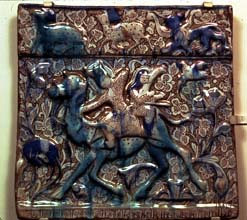 |
OUT OF GENGHIS KHAN'S ASIA--Glazed Camel tile. Photo: Courtesy Metropolitan Museum of Art/2002. |
The Legacy of Genghis Khan:
Courtly Art & Culture
In Western Asia 1256-1353
[Closing 16 February 2003]
The current Brooklyn Museum Hamza show is well worth visiting as an elegant pendant to this amazing survey of the art of the Mongol Rulers in Asia and the Middle East. Genghis Khan's descendants were ferocious warriors, it is true, but those in power developed a taste for the finer things. From marauding nomads, they evolved into highly sophisticated magnates over vast domains. Their power and majesty were, they well understood, enhanced by their patronage of artists, poets, architects, and scholars.
A wonderfully worked golden saddle in the new Met exhibition recalls that the Great Khan and his heirs owed their victories and their spoils to mounted warriors who gave no quarter.
But, savage and barbaric in conquest, they could be magnificent and questing in peace and prosperity. In the Mongol confederacy that Genghis Khan founded and extended through his progeny…
Remarkable stone-carvings, marvelous glazed tiles with geometric and animal designs, priceless illuminated manuscripts: these are only some of the treasures on view at the Met.
Surviving pages from the Shahnama, or Book of Kings, are especially interesting and detailed in their decoration. The BMA Hamza echoes these…
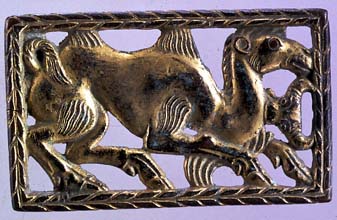 |
NOMADIC ART--Golden Two-Humped [Bactrian] Camel. Photo: Courtesy Metropolitan Museum of Art/2002. |
Nomadic Art of the Eastern Eurasian Steppes
[Closing 5 January 2003] When the Great Khan was still a nomadic warrior, there was no time or place for monumental architecture, immense illustrated books, or massive artworks. The nomads lived in tents and were often on the move, seeking new pasturage and new pillage.Those nomadic tribes of fierce horsemen—who lived on the fringes of civilized communities in Eastern Europe and Western Asia—were not, however, without a tradition of art and elegant artifacts.
However splendid their tent-weavings and garment-textiles may have been, none of these has survived to bear witness to their artistic skills. But what has not been swept away by the sands of time does provide powerful evidence of real talent and imagination.
The harness-fittings, buckles, brooches, and other iron, bronze, silver, and gold decorative objects now on display at the Met are ample proof of this. Not only did their artist/craftsmen stylishly depict horses, camels, and other animals they knew well from daily life. But they also invented imaginary, even legendary animals: horses with wings——even though they had surely never heard of the Greeks' wonderful winged-steed, Pegasus.
My favorite golden object in this show is also its signature-logo: an Asian Bactrian Camel. For the record, the African Dromedary has only one hump. In fact, a two-humped camel looks a bit odd to western eyes, as most zoos favor dromedaries for some reason.
Many objects in the current exhibition are drawn from the collection of Eugene V. Thaw—whose impressive collection of 18th and 19th century drawings is now on view at the Morgan Library.
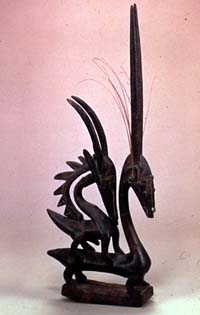 |
GENISIS--Ritual head-dress from Mali now at the Met. Photo: Courtesy Metropolitan Museum of Art/2002. |
GENESIS:
Ideas of Origin in African Sculpture
[Closing 13 April 2003]
Where did the Yoruba People come from? Who created the first of the Dogon? Are they really directly descended from their totem animal, the crocodile? As with various American Indian tribes, greater and lesser African tribes have quite distinctive legends and traditions about The Beginnings. But almost all of them are very closely tied to the natural world in which they have existed for centuries beyond recall.
And, while the totem animal of a tribe is so sacred that no one would dare to kill or eat it, for enemy tribesmen, just such a kill is a magical metaphor for an actual slaying of a hated, feared member of that tribe.
Recently in Rwanda, one tribe didn't bother with killing the totems of the enemy. Thousands, as many as a million of Tutsi men, women, and children "cockroaches" were brutally, viciously slain by the Hutus—with no remorse.
This October in Tanzanian Arusha, the "Beast of Butare" was on trial before an international tribunal for encouraging rape of Tutsi women and girls as an instrument of genocide. Although she said she was too sensitive to kill even a chicken. As Rwanda's Minister for Women and Family Affairs, she is alleged to have given the order to exterminate the very women she was appointed to protect..
So, although the current Met Museum exhibition—complete with ethnic films by Eliot Elifsofon, among others—makes the masks, myths, and magic of various tribes' age-old ceremonies seem colorful and quaint, there are still forces of Dark and Light lurking behind such seasonal annual rituals.
Among the most impressive ritual sculptures on show are the elegant ci wara antelope head-dresses of Mali's Bamana Peoples. There are forty of these—in both male and female versions.
From sub-Saharan Africa, there are also 35 ritual artifacts representing sixteen other tribal traditions relating to the Creation.
I was a bit disappointed not to find a pair of Yoruba Ibeji—or twins. But they relate to the births of twins, not to the creation of the World or of the Tribe.
Owing to infant mortality. at least until recently, one or both twins—an unusual occurrence in Yorubaland—frequently died. As it is still believed that twins are gods come down to earth, their early deaths meant the gods were displeased.
So images of the dead babies were carved, clothed, set in household shrines, and even fed with offerings. In hopes that the gods would relent and return in another set of twins…
The Nigerian artist/musician, Twins Seven-Seven, is a survivor of the seventh set of twins his mother bore. All the earlier twins died…
When I was in Nigeria, I bought a unique set of Ibeji from a wandering trader, out of Dahomey—which is now Benin. Later, Eliot Elifsofon photographed them for my article about Ibeji in Smithsonian magazine.
But even the birth of twins is a kind of Genesis, isn't it? Too bad there are no twins at the Met.
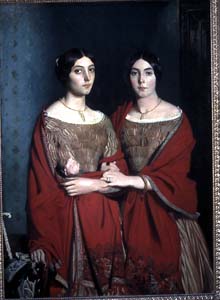 |
SIBLING SUPPORT--French painter Théodore Chassérieu honored his two sisters in oil. Photo: Courtesy Metropolitan Museum of Art/2002. |
Théodore Chassériau: The Unknown Romantic
[Closing 5 January 2003] If Théodore Chassériau has been previously "unknown," then this large Met exhibition should remedy that. The difficulty is that there is a very good reason most people have never heard of him before.On the quantitative—and often large-scale—evidence of Chassériau's various subjects and styles on view, he seems to have been a very good technician. But not an inspired artist. Rather, a follower of trends, a seeker after commissions.
He also died relatively young, having perhaps too early achieved a recognition many greater artists only were accorded in middle-age.
If one is not a devout Catholic, seeing acres of "boiler-plate" religious painting on the Met's walls does not necessarily validate the claims to fame of an artist of the second rank.
Part of the problem may be that the Met wants to honor France and its historic artists with major blockbuster exhibitions from time to time. And they are running out of uncelebrated geniuses…
So why not give French Painters a rest for a while?
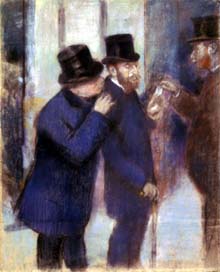 |
WATCH YOUR WALLET!--Edgar Degas' sketch of Parisian stock-market speculators-from the Levin Collectin. Photo: Courtesy Metropolitan Museum of Art/2002. |
A Very Private Collection:
Janice H. Levin's Impressionist Pictures
[Closing 9 February 2003]
The late Janice Levin has been a very generous patron of the Met Museum. Both with paintings and donations. Unlike Met donors Jack and Belle Linsky, at least she didn't require a set of her own rooms to display her treasures.
Instead, they are on view in a small section of the very large evocation of the Lehman Mansion, which showcases the Lehman taste and buying-power in acquiring important European artworks of the distant past.
In fact, not all the fine canvases and bronzes on display have been or are gifts to the Met. The National Gallery and MoMA have loaned pictures the Levin Foundation has given to their collections for this exhibition, to show the breadth and variety of the Levin's collecting interests.
There are some impressive smaller works here, but for the most part, it is a survey of the Usual Suspects: Renoir, Pissarro, Bonnard, Degas, Monet, Cassatt, Toulouse-Lautrec.
Of these, I especially admired Degas' A la Bourse: Portraits of top-hatted financiers with whom I would not trust a sou of my pension-fund.
Nonetheless, in this general context, Giacometti's Bust of Diego is a pleasant surprise. Especially now, when—thanks to Julie Taymor's Frida—Diego Rivera is back in vogue.
French 19th Century Drawings
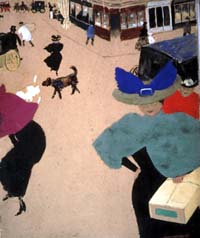 |
THE NABIS LIKED FLAT IMAGES--Félix Vallotton's "Paris Street Scene" faithful to creed of artists' circle. Photo: Courtesy Metropolitan Museum of Art/2002. |
In the Robert Lehman Collection
[Closing 9 February 2003] From the number and quality of French drawings from the Lehman Collection now on view—just a few steps from the Levin Collection—it might seem that the Lehmans had more money and got there first. Or dealt with Duveen, as did Pierpont Morgan.Beginning their careers, could Renoir, Monet, Manet, and Degas ever have imagined how many artworks they would have to create to help wealthy New Yorkers—and rich art-patrons beyond the Hudson—bolster their considerable self-esteem with notable collections of French paintings and drawings?
There are many impressive images in this selection from the Lehman archives. Among my favorites are some experiments by Signac, Seurat, and Henri-Edmond Cross. The latter is very well represented, but the most arresting for me is his Landscape with Stars. For a moment, it reminded me of Van Gogh's astral visions.
Both these shows are worth a visit to the Lehman Wing. But the Levin selection seems rather like a pendant to the Lehman. Nice choices, but not overwhelming images.
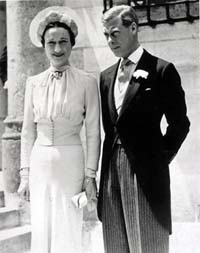 |
LEADERS OF "THE WINDSOR SET"--Cecil Beaton's photo of the Windsor's Wedding sets the style of current Met Costume Show. Photo: Courtesy Metropolitan Museum of Art/2002. |
Blithe Spirit: The Windsor Set
[Closing 9 February 2003] Is the Costume Institute running out of outstanding gowns or unusual ethnic outfits?Is it in danger—as with French Painting—of having to settle for margins and footnotes?
The fact that the Chanels, Lanvins, Vionnets, and Schiaparellis now on view in Blithe Spirit are mostly black or dark-hued, fairly somber, and restrained in silhouette may well be owing to their former exhibition-provenance.
They were assembled originally, in 1940, as a wartime benefit for French War Charities. The show was titled Paris Openings: 1932-1940.
Those of us who can remember all the way back to 1939, the Nazi Occupation of Paris, and the Blitzkrieg of London may well wonder what kind of 1940 Paris Openings were on offer. And whether Nazi Officers sat in the front rows, with their French Collaborationist cuties?
Aside from some glittering decorations on otherwise chastely sedate black gowns, there is little in this show to excite much visual interest. Only historical…
Two wardrobe trunks—with the triple ostrich-plumes of the Prince of Wales—reminded one of that famous Sotheby's sale of Windsor Treasures. Including the diminutive Duke's Tyrolean outfits…
Yes, the Duchess of Windsor was a bitch on wheels, but she was also a very stylish lady. This show could have used some more of Sotheby's leftovers, and less of what was worn by her "set."
As for the jaunty title of this show, it is derived from Noël Coward's period comedy, set in that distant time. Coward borrowed the phrase from Shelley's skylarky poem: "Bird thou never wert…"
What might Shelley have said of the Duchess of Windsor's wardrobe? Or of Noël Coward's, for that matter?
RICHARD AVEDON Portraits
[Closing 5 January 2003] It certainly doesn't hurt his work that Richard Avedon has had access to the Great and Famous of this world for major portraits—for even more major publications.Nor that his preferred portrait-format, developed over time, is the black-and-white subject against a stark white background. This works very well in glossy magazines, especially when the format can be fairly large.
In major exhibitions, when Avedon can reproduce his already famous, even iconic, images on a very large scale, the effect is stunning!
And yet even his pictures of totally unknown people are memorable. And still powerful, even in snapshot-size formats.
The nude bee-keeper, his bare flesh crawling with bees—the poster-child for the current Met photo-show—would still be an arresting image without the bees. He looks like a fugitive from the Living Dead.
Avedon's drifters are something special. Beyond Walker Evans and Dorothea Lange…
One of Avedon's effects is surely his ability to get his subjects to relax and be as unself-conscious as possible—even without their clothes. In a group shot of Andy's Factory Friends, Taylor Meade is his essential self.
A very busty & sequined Marilyn Monroe is looking away, as though she has forgotten something and simply cannot remember what it was.
The companion-book is also something rather special. It is bound in a zigzag format. When you stretch it out, you have a long run of major Avedon portraits in a row. It is a stunning exercise in black-and-white photo-images.
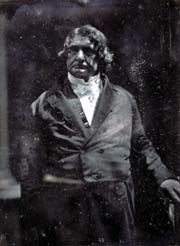 |
LEMUEL SHAW POSES FOR HIS PORTRAIT--Southworth & Hawes photo from Met/Gilman archives. Photo: Courtesy Metropolitan Museum of Art/2002. |
Portraits: A Century of Photographs
[Closing 12 January 2003] This unusual sampling of the historic photo-collections of the Met and the Gilman Paper Company is a handsome pendant to the high-powered Avedon show.
It spans the years from the early Daguerreotypes to the genius of Diane Arbus.
My favorite is the handsome portrait of Lola Montez! She was photographed in New York just after she had astonished audiences with her show: My Life and Loves.
She had been the mistress of Franz Liszt and King Ludwig I of Bavaria. Louis lost his throne, and Lola was driven into exile. After New York, she triumphed in San Francisco and retired to my home-town, Grass Valley, CA, where she bought the only home she was ever to know.
Lola is buried in Brooklyn's Green-Wood Cemetery. Obviously, there was no photo of Lola's grave in this show.
A simple white stone with the name Mrs. Eliza Gilbert is not a portrait-subject. For the record, however, I have photographed it for my INFOTOGRAPHY ARTS ARCHIVE.
Kafka & Gottlieb at the Jewish Museum:
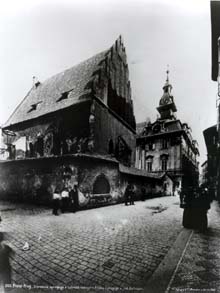 |
FRANZ KAFKA'S PRAGUE--Medieval Jewish City Hall and Old/New Synagogue as author of "The Castle" knew them. Photo: Courtesy Jewish Museum/2002. |
The City of K.: Franz Kafka and Prague
[Closing 5 January 2003] One of the several remarkable things about the twelve Kafka & Prague imaginary environments now on view at the Jewish Museum is that they were conceived and designed not by a Czech. But by a gifted Catalan artist from Barcelona: Juan Insua.In fact, this multi-media installation is one of a Barcelona exhibition cycle: Cities and Their Writers. In recent years, Barcelona has become an exciting center of new movements in the arts, especially the performing arts. And this unusual show is in itself a form of theatre.
Unfortunately, Prague and the entire Czech Republic have lost that dynamic creativity in all the arts which was engendered by the Cold War and trying to get round the Communist Censors. The almost iconic dissident playwright, Vaclav Havel, is too busy being President to write any more of those fanged satires which Prague now needs so much.
Franz—or Frantisek, to use his Czech name—Kafka in his rather brief life-span had nothing like the social and intellectual influence of Vaclav Havel through his writings.
Indeed, fame, success, and even general approval eluded Kafka in life, only to burgeon after he was gone. And, although Prague, the Praguers, and the daily routine of office-work for the Austro-Hungarian government deeply influenced his writing, Kafka was not a Czech.
Kafka was a German-Jew of the middle-class, in a society where Czechs resented Germans, and Jews even more. Even the German Germans resented the Jews.
Kafka toiled away for years in the Worker's Accident Insurance Bureau, an experience with bureaucracy which infuses his major works. Both The Trial and The Castle reflect the impotence and confusion of the ordinary man, confronted with a senseless system which cannot be questioned or altered.
There is—at least briefly as young men—a parallel between Albert Einstein and Franz Kafka. Einstein worked in the Swiss Patent Office, employment not unlike Kafka's. And, just as Kafka wrote in his free time, Einstein formed one of his most important theories in off-hours.
The Prague into which Kafka was born—and in which he lived—was still rather medieval, with narrow streets, ancient houses, and the mighty Hrad castle and St. Vitus Cathedral looming over the Old Town from the heights across the River Moldau.
The Old-New Synagogue and other monuments in the Jewish Quarter looked as though the Golem had only recently rampaged among them.
The first seven installations of the Kafka exhibition evoke Kafka in Prague as Existential Space. These include circles of gauze on which "Life in a Circle" images are projected. Kafka's interest in Yiddish Theatre—which his domineering father disparaged—is invoked, as well as his romantic involvements—which never led to marriage.
The remaining five installations are even more abstract and metaphoric. These suggest for Prague an Imaginary Topography—as it appears in his novels and stories. The soul-killing routine of a government office is evoked as viewers walk between walls of giant filing-cabinets. Some drawers are open to disclose photos, first-editions, and even some overly officious documents.
Toward the end of the installations, The Threshold is evoked in an architectural image which does indeed suggest a crossing-over. From which there can be no return…
Light-levels are low because there are so many things written and printed which could fade even more under strong illumination. Fortunately, the wall-texts are all quite clear.
This is a fascinating Kafka-Maze in which you can become lost in thought, if not in fact. Its haunting images remain long after.
But then, if Kafka's life had been free of his disapproving father, his boring office-routine, his debilitating tuberculosis, his search for his Jewishness, and his sense of Alienation and Otherness, there would have been no Gregor Samsa. No Castle. And no Trial.
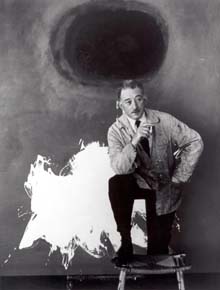 |
ADOLPH GOTTLIEB TAKES A SMOKE-BREAK FROM ABSTRACT EXPRESSINISM. Photo: Courtesy Jewish Museum/©Adolph & Esther Gottlieb Foundation. |
ADOLPH GOTTLIEB: A Survey Exhibition
[Closing 2 March 2003] Adolph Gottlieb's powerful retrospective now at the Jewish Museum was—like its current Kafka—organized in Spain. But Gottlieb is no stranger to this innovative New York museum. He received his first retrospective at the Jewish Museum in 1957.In fact, that show was the first major museum show in New York of an Abstract Expressionist artist!
Although Gottlieb's evolving styles and palette owed nothing to his fellow Abstractionists such as Jackson Pollock, Mark Rothko, and Barnett Newman, he was certainly a spokesman for them as an avant-garde group of painters.
Their powerful and often disturbing works soon came to dominate the international art-scene. European imitators were not long in emerging, but some of them definitely owed a lot to Gottlieb's work.
The current show doesn't merely focus on Gottlieb's development as an Abstract Expressionist from the late 1950s onward. Instead, it is an "Artistic Odyssey," beginning in 1934, and concluding with Burst 1973, finished shortly before his death.
Gottlieb's Bursts are something very special.
Sanford L. Smith Presents:
Art of the 20th Century
[From 21-24 November 2002/Park Avenue Armory] The Armory Shows produced by Sanford Smith and his Associates always offer a strong representation of established—and often celebrated—artists & artisans. What's more, they can be counted upon to introduce striking new talents as well.Art of the 20th Century, just completed, was especially interesting on both counts. If you bought Picasso or Chagall lithographs years ago, judging from current prices at this show, you have virtual Money in the Bank.
Among unusual works—and talents—which caught my eye at the Armory were the "Properspectives" of Patrick Hughes. I'd first seen his work—without making a point of writing down his name—in the new British Library, by St. Pancras Station.
This deceptively simple perspective painting is mounted behind the great glass cube which holds The King's Library of rare books. It echoes these glassed-in stacks in that—matted under glass—it shows a panoramic picture of sections of book-stacks.
What is unsettling at first and ultimately amazing is that, as one walks past the picture, the angles of the avenues of bookshelves continually change. It is as if the picture itself is animated, yet it is the viewer only who is in motion.
Hughes is a Master of Forced Perspective. His most successful pieces have painted wedges which jut out from the picture-plane.
For Frozen Motion of the Ocean, Hughes has painted identical images of a door on the viewer's left-hand side of each of the wedges. On the right-hand of the wedges are segments of waves breaking on the shore, extending onto the floor-boards on the picture-plane.
Approached from the left, this looks like a row of white doors. As one passes, the doors open up to reveal five sections of the waves. Almost past the picture, the view is of the entire row of waves, sans doors.
Unfortunately, these effects do not reproduce in flat photographs. You have to see and experience the actual paintings. You will surely be impressed, possibly enthralled.
Passing by six wall-shelves with rows of pointy women's shoes, I thought immediately of Imelda Marcos. But she could never put these on her feet.
Artist Steve Tobin has, however, filled these shoes with asparagus, grapes, and many other foodstuffs. This is Shoewall, also on display in Beverly Hills at Spago Restaurant. Mme. Marcos has not bought a pair of Tobin's shoes thus far, I was told.
Tobin also has some important new works—Naked Earth—on display in Los Angeles at the Natural History Museum and the Page Museum at the La Brea Tar Pits. Among these are Termite Mounds, Bone Wall, Pine Cone, and Roots—cast in bronze from nature.
Most amazing of all the art-novelties in this eclectic show are the small-scale interiors of Charles Matton. They are distantly related to the miniature period Thorne Rooms at the Chicago Art Institute and in Phoenix.
But they are more than tiny reconstructions of generic periods of architecture, furnishings, and decoration. In some cases, they seek to suggest actual rooms with artistic or historic resonances.
But they are not surreal or abstract in their homages, like the boxes of Joseph Cornell. No Medici Slot-Machines for Matton.
His recent exhibition at the Forum Gallery—745 Fifth Avenue at 57th—was called Within These Walls. Matton manages to replicate foreground details of some of his rooms into infinity. It's all done with mirrors. No smoke.
His evocation of the University Club's Renaissance Florentine Library uses a one-way mirror as its framing glass, so that the arcades of book-stacks seem to recede into the ultimate Vanishing Point upstage. Yes, each is indeed a Little Theatre, as well, but minus actors.
Matton's Library: Homage to Marcel Proust certainly suggests the author of Remembrance of Things Past. The scores of tiny books on the shelves were all handmade by Matton.
Also on display at the Park Avenue Armory were Matton's Saskia Awaiting Titus, Bedroom of a Collector, and Rhinoceros—Homage to Eugene Ionesco.
A small painting by Gabriele Münter caught my in the booth of Munich's Galerie Thomas. Silke Thomas gave me handsome brochures for her Bavarian shows of Kandinsky & Friends and Spass und der Freud'.
I used to teach in Murnau—way back in 1958—so I knew well the old "Russ Haus" Gabriele Münter shared with her lover, Kandinsky. He even painted her wooden staircase with charming designs—which you can still see, for the house is now a museum.
Thomas specializes in German Expressionism and contemporary art—including the un-German Botero. Major painters of Die Brücke, Blauer Reiter, and the Bauhaus are also represented.
Michael Goedhuis Contemporary was showing modern Chinese artists. Especially arresting were the wildly brushed water-color images of Wang Jinsong and Zeng Shanqing.
Hardly a gallery in this expansive exhibition failed to field at least several outstanding works by known or new artists. Don't miss the next one.
Sanford Smith will be showing Works on Paper in late February at the Armory. For more information about his shows: www.sanfordsmith.com
INTERNATIONAL CENTER OF PHOTOGRAPHY:
First International Triennial in the United States
[Opening September 2003] Although photography has already achieved full status as an art-form—especially owing to ground-breaking exhibitions by the Museum of Modern Art and the Whitney Museum in Manhattan—it is still something of a Modernist step-sister to painting and sculpture.Obviously that has a lot to do with the fairly recent perfection of cameras, lenses, and film-stocks. Oddly enough, even a fuzzy sepia image now has quasi-art status if it is old enough.
Vintage photos don't have to be of very good quality. It's the lost-and-gone-forever subject-matter that makes them collectors' treasures.
The International Center of Photography by no means ignores photography's birth-pangs. But it is much more interested in promoting public interest in modern photography, especially newcomers and mid-career photo-artists.
That is why it will launch the first US Triennial International Photography Exhibition in September. Its curators have been searching at home and abroad for outstanding images by unusual artists.
This landmark show will be staged in the ICP Galleries on Sixth Avenue and 43rd Street. Most of the show-space is below grade, as are the state-of-the art ICP School Campus and Collections across the street—in what used to be the Library of the CUNY Grad Center.
The theme of this first-ever Triennial is Strangers. ICP Chief Curator Brian Wallis explains that the images will explore the social world through encounters with people unknown to one another. In both public and private situations.
As I seldom photograph people in any situations, I guess I'm out of luck as an unknown photographer. If you have never had a photo-show or a photo-book by age 74—but have been photographing for half-a-century—are you mid-career? Or what?
I do have that new shot of a street-kid in Cape Town robbing a drunk. Will that do it? Or the Zulu girl in Shakaland who took off her scarf to show her bare breasts when I prepared to take a shot? She wasn't embarrassed. I was.
As I was less than excited over the photos on view in Kassel at Documenta XI, I may also be out of sync with the ICP, for I see that Curators Wallis, Phillips, and Squiers were all on hand there this summer.
For general info about the ICP and its shows, phone: 212-857-0045. Or check out the website: www.icp.org [Loney]
Copyright © Glenn Loney 2002. No re-publication or broadcast use without proper credit of authorship. Suggested credit line: "Glenn Loney, Curator's Choice." Reproduction rights please contact: jslaff@nymuseums.com.